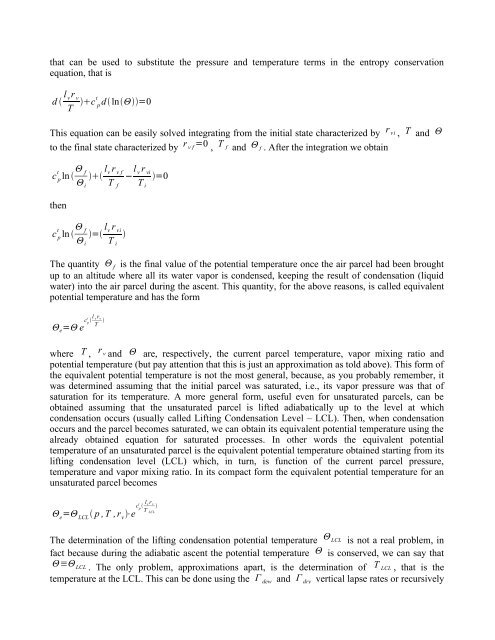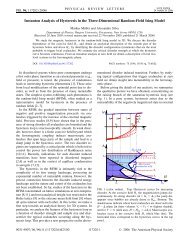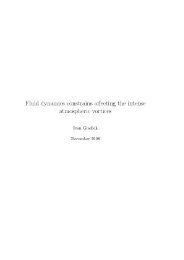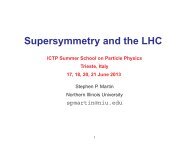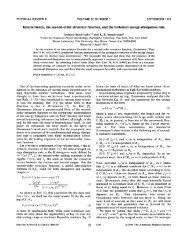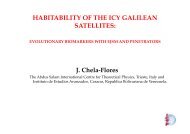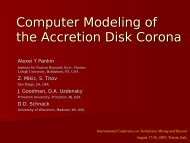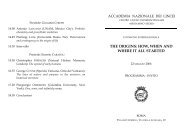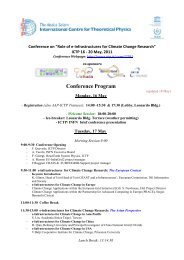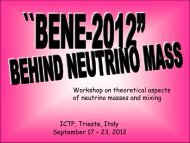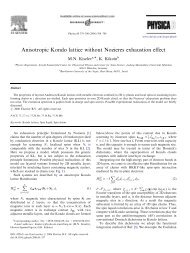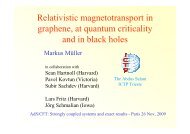Moisture and Temperatures in the Atmosphere - ICTP
Moisture and Temperatures in the Atmosphere - ICTP
Moisture and Temperatures in the Atmosphere - ICTP
Create successful ePaper yourself
Turn your PDF publications into a flip-book with our unique Google optimized e-Paper software.
that can be used to substitute <strong>the</strong> pressure <strong>and</strong> temperature terms <strong>in</strong> <strong>the</strong> entropy conservation<br />
equation, that is<br />
d l vr v<br />
T c t<br />
p d lnΘ=0<br />
This equation can be easily solved <strong>in</strong>tegrat<strong>in</strong>g from <strong>the</strong> <strong>in</strong>itial state characterized by r vi , T <strong>and</strong> Θ<br />
to <strong>the</strong> f<strong>in</strong>al state characterized by r v f =0 , T f <strong>and</strong> Θ f . After <strong>the</strong> <strong>in</strong>tegration we obta<strong>in</strong><br />
t Θ f<br />
c p ln <br />
Θ i<br />
lv r v f<br />
−<br />
T f<br />
l v r vi<br />
=0<br />
T i<br />
<strong>the</strong>n<br />
t Θ f<br />
c p ln <br />
Θ i<br />
= lv r vi<br />
<br />
T i<br />
The quantity Θ f is <strong>the</strong> f<strong>in</strong>al value of <strong>the</strong> potential temperature once <strong>the</strong> air parcel had been brought<br />
up to an altitude where all its water vapor is condensed, keep<strong>in</strong>g <strong>the</strong> result of condensation (liquid<br />
water) <strong>in</strong>to <strong>the</strong> air parcel dur<strong>in</strong>g <strong>the</strong> ascent. This quantity, for <strong>the</strong> above reasons, is called equivalent<br />
potential temperature <strong>and</strong> has <strong>the</strong> form<br />
Θe=Θ e c t l v rv p<br />
T <br />
where T , r v <strong>and</strong> Θ are, respectively, <strong>the</strong> current parcel temperature, vapor mix<strong>in</strong>g ratio <strong>and</strong><br />
potential temperature (but pay attention that this is just an approximation as told above). This form of<br />
<strong>the</strong> equivalent potential temperature is not <strong>the</strong> most general, because, as you probably remember, it<br />
was determ<strong>in</strong>ed assum<strong>in</strong>g that <strong>the</strong> <strong>in</strong>itial parcel was saturated, i.e., its vapor pressure was that of<br />
saturation for its temperature. A more general form, useful even for unsaturated parcels, can be<br />
obta<strong>in</strong>ed assum<strong>in</strong>g that <strong>the</strong> unsaturated parcel is lifted adiabatically up to <strong>the</strong> level at which<br />
condensation occurs (usually called Lift<strong>in</strong>g Condensation Level – LCL). Then, when condensation<br />
occurs <strong>and</strong> <strong>the</strong> parcel becomes saturated, we can obta<strong>in</strong> its equivalent potential temperature us<strong>in</strong>g <strong>the</strong><br />
already obta<strong>in</strong>ed equation for saturated processes. In o<strong>the</strong>r words <strong>the</strong> equivalent potential<br />
temperature of an unsaturated parcel is <strong>the</strong> equivalent potential temperature obta<strong>in</strong>ed start<strong>in</strong>g from its<br />
lift<strong>in</strong>g condensation level (LCL) which, <strong>in</strong> turn, is function of <strong>the</strong> current parcel pressure,<br />
temperature <strong>and</strong> vapor mix<strong>in</strong>g ratio. In its compact form <strong>the</strong> equivalent potential temperature for an<br />
unsaturated parcel becomes<br />
Θ e =Θ LCL p ,T ,r v ⋅e c p<br />
t lv r v<br />
<br />
T LCL<br />
The determ<strong>in</strong>ation of <strong>the</strong> lift<strong>in</strong>g condensation potential temperature Θ LCL is not a real problem, <strong>in</strong><br />
fact because dur<strong>in</strong>g <strong>the</strong> adiabatic ascent <strong>the</strong> potential temperature Θ is conserved, we can say that<br />
Θ≡Θ LCL . The only problem, approximations apart, is <strong>the</strong> determ<strong>in</strong>ation of T LCL , that is <strong>the</strong><br />
temperature at <strong>the</strong> LCL. This can be done us<strong>in</strong>g <strong>the</strong> Γ dew <strong>and</strong> Γ dry vertical lapse rates or recursively


